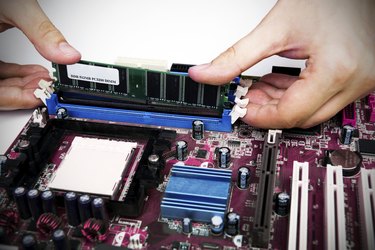
Unless you're a tech enthusiast, it's hard to maintain much interest in the differences between computer memory standards. Memory is described with a blizzard of acronyms and performance figures, which convey relatively little to nontechnical users. You might walk away wondering about the difference between one model's SDRAM and another's SODIMMs, without receiving any satisfactory explanation. In truth, the RAM used by almost all modern computers is SDRAM. SODIMMs are simply a small version of the standard RAM stick.
The Memory Dance
Video of the Day
The RAM in your computer is largely similar to the memory in your USB thumb drive, but there's a significant difference. Your thumb drive's chips are static RAM, meaning that once the data is written, it stays put. Your computer's memory is dynamic, meaning it must be refreshed at set intervals. That's the "D" in SDRAM, and its why data is lost if your computer loses power and can't refresh the chips. The "S" in SDRAM means it's synchronous -- regulated to mesh with your CPU. When the CPU is prepared to accept the next block of data from memory, your SDRAM ensures the data is ready to go at the same time.
Video of the Day
Getting DIMM
Modern SDRAM comes in the form of dual in-line memory modules, more conveniently abbreviated as DIMMs. They're manufactured in the form of small boards, or "sticks," roughly 5 1/4 inches in length. DIMMs have a row of memory chips down each side, a space-saving improvement over older-generation single in-line memory modules or SIMMs. The DIMMs used in desktop and server computers have either 240 or 284 pin connections, divided equally between the front and back.
Honey, I Shrunk the DIMMS
Conventional DIMMs work well in desktop and server computers, but fitting 5-inch RAM sticks into modern, lightweight laptops isn't practical. That's where SODIMMS enter the picture. They function in exactly the same as with conventional DIMMS, but SODIMMS are physically scaled down. The "SO" in the acronym stands for "small outline," a reflection of their diminutive size. SODIMMS are approximately half as long as conventional DIMMS and a third the thickness, with either 200 or 204 pins. Packing comparable memory capacity into these tiny chips enables manufacturers to make thinner, smaller, lighter laptops, or tiny servers for business applications.
Testing 1, 2, 3, 4
At the turn of the century, the earliest DIMMs were superseded by a new technology called dual data rate or DDR DIMMs. DDR used both halves of your computer's clock cycle -- the "tick" and the "tock," so to speak -- to transfer data, greatly increasing memory performance. Newer DDR2, DDR3 and DDR4 standards have steadily increased RAM performance and lowered power consumption for both standard DIMMs and SODIMMs, but they're not interchangeable. Your motherboard and its chipsets are designed for one or another, and you can only use that style. DDR4 machines use a newer socket with more pins, so older chips simply won't fit. DDR2 and DDR3 chips use the same number of pins, but the notch or "key" is in a different place so you can't confuse them.